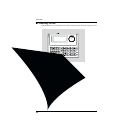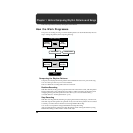
38
Chapter 1 Before Composing Rhythm Patterns and Songs
This section provides a summary description of the DR-670.
How the Work Progresses
The process of creating one song’s worth of rhythm patterns can be divided broadly into two
steps: creating the patterns, then composing the song.
fig.01-01
Composing the Rhythm Patterns
Compose (record) the performance patterns that constitute the sections or parts of the song.
You can create up to 200 of your own User Patterns.
There two different recording methods are shown below.
Realtime Recording
With this method, the key pads are played in time with a metronome count, with the pattern
being recorded just as it is performed. Even if there is a little unevenness in the timing used
in tapping the key pads, the Quantize function allows you to record with the timing
corrected. (Refer to “Set the Quantization” p. 55)
Step Recording
With this recording method, the timing for playing instrument sounds (steps), volume levels,
and other aspects of the pattern are specified one by one. This allows patterns to be recorded
accurately, even those that are hard to record using Realtime Recording.
You can also record patterns using both Realtime and Step Recording.
After recording the basic pattern using Step Recording, finish creating the Pattern by using
Realtime Recording to add sounds in a freer ad-lib style.
Realtime
Recording
Step
Recording
Pattern Recording
User Pattern
Preset Pattern
Realtime
Recording
Step
Recording
Song Recording
Song


















